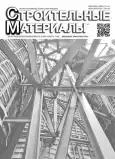Investigation of the hydration processes of magnesia stone from mechanoactivated caustic dolomite
- Authors: Ibragimov R.A.1, Bikaeva Y.V.1
-
Affiliations:
- Kazan State University of Architecture and Engineering
- Issue: No 7 (2025)
- Pages: 63-71
- Section: Статьи
- URL: https://rjsvd.com/0585-430X/article/view/688702
- DOI: https://doi.org/10.31659/0585-430X-2025-837-7-63-71
- ID: 688702
Cite item
Abstract
Alternative Portland cement binders with low carbon dioxide emissions are currently being developed. One of them is caustic dolomite, which has low activity of magnesium oxide. The increased activity of magnesium oxide by mechaonoactivation in vortex layer devices will allow high-hydration magnesite stone and improved physico-mechanical characteristics. In this study we investigated the caustic dolomite powder and magnesium stone based on it. The X-ray phase analysis of the Rigaku SmartLab diffractometer was used to determine phase composition and structure. The hydration products were confirmed by results from differential thermal analysis in the STA 6000.The structures morphology, density, and compaction degree were assessed by the Merlin scanning electron microscope. It was found that, as a result of the mechaonochemical activation of caustic dolomite, а densely packed crystalline structure of magnesite stone is formed with a reduced porosity value, reduced crystallite sizes and unavailability of shrinkage cracks, which is a consequence of high contact density of crystallizing phases, accompanied by a general increase in strength of the magnesia stone. It has been proven that the activation of caustic dolomite contributes to the intensification of the hydration processes and to the formation of spatially-linked microstructure of magnesia stone due to stable phases of three-pentaoxyhydrochlorides, to a reduction in the porosity of the stone by 1,69 times and to reduction in the size of magnesium oxide crystals of 20% - up to 20,6 nm.
Full Text
About the authors
R. A. Ibragimov
Kazan State University of Architecture and Engineering
Author for correspondence.
Email: rusmag007@yandex.com
Candidate of Sciences (Engineering)
Russian Federation, 1, Zelenaya, Kazan, 420043Yu. V. Bikaeva
Kazan State University of Architecture and Engineering
Email: uliyaevstigneeva@mail.ru
Engineer
Russian Federation, 1, Zelenaya, Kazan, 420043References
- Kramar L.Ya., Chernykh T.N., Trofimov B.Ya. Features of hardening of magnesia binder. Tsement i yego primeneniye. 2006. No. 5, pp. 58–61. (In Russian). EDN: HVTBQF
- Tooper B., Cartz L. Structure and formation of magnesium oxychloride sorel cement. Nature (London). 1966. Vol. 211. 5044, pp. 64–66. https://doi.org/10.1038/211064a0
- Berdov G.I., Zyryanova V.N., Ilyina L.V., et al. Interphase interaction and mechanical strength of composite binders. Part 2. Cement materials. Tekhnika i tekhnologiya silikatov. 2014. Vol. 21. No. 4, pp. 2–8. EDN: TBJBUT
- Koshelev V.A., Averina G.F., Orlov A.A., Kramar L.Ya. Study of the decrease in the activity of magnesite binders with a low content of magnesium oxide. Vestnik of the South Ural State University. Series: Construction and Architecture. 2020. Vol. 20. No. 4, pp. 42–46. (In Russian). EDN: VYQPQU. https://doi.org/10.14529/build200405
- Bassioni G., Farid R., Mohamed M. et al. Effect of different parameters on caustic magnesia hydration and magnesium hydroxide rheology: A review. Materials Advances. 2021. Vol. 2. Iss. 20, pp. 6519–6531. EDN: YFNHYF https://doi.org/10.1039/d0ma00887g
- Belousov M.V., Selivanov E.N., Gulyaeva R.I., Tyushnyakov S.N., Rakipov D.F. Thermodynamics and kinetics of the process of thermal dissociation of dolomite. Izvestiya of universities. Non-ferrous metallurgy. 2016. No. 2, pp. 18–25. EDN: VXLGIP. https://doi.org/10.17073/0021-3438-2016-2-18-25
- Zuo Z., Tao Y., Yang J., Shen B., Zhang Y. Effect of electrolytic manganese residue and phosphoric acid on the properties of magnesium oxychloride cement: Strength and water resistance. Construction and Building Materials. 2025. Т. 463. pp. 140081. EDN: TFHYYV. https://doi.org/10.1016/j.conbuildmat.2025.140081
- Shu J., Liu R., Liu Z., Chen H. Solidification/stabilization of electrolytic manganese residue using phosphate resource and low-grade MgO/CaO. Journal of Hazardous Materials. 2016. Vol. 317, pp. 267–274. https://doi.org/10.1016/j.jhazmat.2016.05.076
- Dehua D., Chuanmei Z. The formation mechanism of the hydrate phases in magnesium oxychloride cement. Cement and concrete research. 1999. Vol. 29. No. 9, pp. 1365–1371. EDN: ADURHH. https://doi.org/10.1016/S0008-8846(98)00247-6
- Lojka M., Jankovský O., Jiříčkováet A. al. Thermal stability and kinetics of formation of magnesium oxychloride phase 3Mg(OH)2∙MgCl2∙8H2O. Materials. 2020. Vol. 13 (3). 767. EDN: AXILIU. https://doi.org/10.3390/ma13030767
- Khudyakova L.I., Voiloshnikov O.V., Kotova I.Yu. Influence of mechanical activation on the formation process and properties of composite binders. Stroitel’nye Materialy [Construction Materials]. 2015. No. 3. pp. 37–41. EDN: TLRUTX
- Patent of the Russian Federation 2222508. Sposob izgotovleniya stroitel’nykh materialov na magnezial’nom vyazhushchem [Method of manufacturing building materials on a magnesite binder]. Usov M.V. Declared 20.08.2002. Published 27.01.2004. EDN: SXTWLC
- Patent of the Russian Federation 2525390. Method of manufacturing building materials on magnesite binder [Method for the production of building materials on a magnesite binder] Malysheva R.D., Siplivyy B.N. Declared 09.01.2013. Published 10.08.2014. EDN: OQTKLH
- Bikaeva Y., Ibragimov R., Korolev E., Kiyamov I., Kiyamova L. Low-temperature calcination composite binder from dolomite and its application to facing board materials. Case Studies in Construction Materials. 2023. Vol. 19. e02338. EDN: KVAJTM. https://doi.org/10.1016/j.cscm.2023.e02338
- Ibragimov R.A., Krolev E.V., Deberdev T.R., Leksin V.V. Strength of heavy concrete on Portland cement processed in a vortex layer apparatus. Stroitel’nye Materialy [Construction Materials]. 2017. No. 10, pp. 28–31. (In Russian). EDN: ZRPHGT
- Bikaeva Yu.V., Ibragimov R.A. Structure and properties of magnesite stone obtained by activation of caustic dolomite. Vestnik MGSU. 2024. Vol. 19. No. 10, pp. 1629–1640. (In Russian). EDN: AQDADW. https://doi.org/10.22227/1997-0935.2024.10.1629-1640
- Ibragimov R.A., Korolev E.V., Bikaeva Yu.V., Larionov I.S. The contact angles of quartz and caustic dolomite powders after mechano-magnetic treatment. Stroitel’nye Materialy [Construction Materials]. 2024. No. 3, pp. 64–70. (In Russian). EDN: CUIUFP. https://doi.org/10.31659/0585-430X-2024-822-3-64-70
Supplementary files















